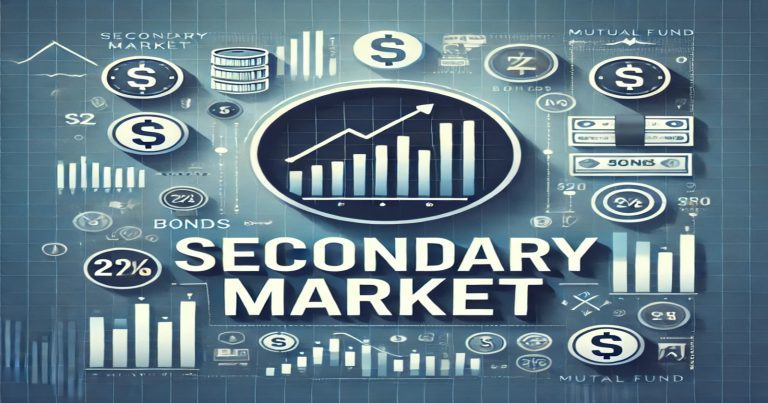The secondary market plays an essential role in the financial system by allowing securities trading, which is already issued and comprises stocks, bonds, and derivatives. This liquidity, transparency, and price discovery for buying or selling securities are essential. Secondary market examples include stock exchange trading between different parties through various exchange systems like the NSE, BSE, or NYSE, while institutional investors also trade bonds. The article discusses the definition of the secondary market, its examples and functions, its benefits and some of its limitations.
What is Secondary Market?
Investors in the secondary market purchase and sell already-issued securities. The key difference here is that while in the primary market, a security is first issued, the secondary market serves to transfer ownership among investors. Through the secondary market, liquidity occurs for investors as it allows them to get out of investments if they wish.
Trading in the secondary market occurs on either an organized stock exchange or over-the-counter or OTC, market platforms. The prices fluctuate according to the available supply and demand, resulting in a very transparent transaction environment. Secondary markets include the Bombay Stock Exchange in India, the National Stock Exchange, and trading between bonds or mutual funds investors.
Secondary Market Examples
Secondary market transactions occur in different forms, and the most traded securities are stocks, bonds, and mutual funds. Let’s discuss some key examples:
Stock Trading on Stock Exchanges
The secondary market offers the comfort of a stock exchange through which investors trade their shares among themselves on any stock exchange such as NSE, BSE, or NYSE. For instance, Reliance Industries’ shares are actively traded on NSE and BSE. When one investor sells his Reliance shares to another, the company does not receive the money since the buyer pays the seller at the prevailing market price.
This process is also crucial in offering liquidity to the investors; through this process, they can buy or sell shares whenever needed. This way, it continuously makes share prices based on demand and supply during the trading systems and is fair and transparent.
Bond Trading in the Secondary Market
Companies or governments issue bonds in the primary market, which are later traded in the secondary market. For example, G-Secs are government bonds traded among institutional investors like banks, mutual funds, and insurance companies in India. A mutual fund may sell a 10-year government bond to a bank in the secondary market.
This is because the trading enables investors to sell their bonds before maturity, offering them flexibility and liquidity. The trading also determines the bond’s market value by using current interest rates and, therefore, ensures transparency in the pricing system.
Mutual Fund Unit Trading
Like an ETF, mutual fund units can be traded on stock exchanges in the secondary market. For instance, a person can buy and sell SBI ETF Nifty 50 units on the NSE, just like trading shares.
This is important because it allows investors to sell mutual fund units at market prices during trading. Thus, it would ensure liquidity since investors can quickly enter or leave their investments anytime.
Derivative Contracts in the Secondary Market
Derivatives include futures and options, which are highly traded in the secondary market. For example, Nifty 50 futures and options are actively traded on the NSE platform in India. These contracts derive value from the Nifty 50 index, enabling investors to hedge risks or make speculative trades.
This type of trading is essential because it allows investors to manage risk, go for leverage, and seek profit potential even with unpredictable markets. It gives a sense of flexibility, therefore giving tools for protection and maximization of return on investment.
Foreign Exchange (Forex) Market
The Forex market is a large secondary market that deals in currencies. For example, the USD/INR pair is traded frequently, allowing institutional investors to purchase US dollars against Indian rupees. It will thus allow them to manage currency risks better.
Forex plays a huge role in international trade and investment. It gives high liquidity, which means a smooth exchange of currencies will make it possible for businesses and economies to function across borders.
Functions of Secondary Market
The functions of secondary market are multifaceted, as it benefits investors and the economy in general. This is because trading securities allows vibrant financial ecosystems to be created and funds allocated effectively, enabling the participants to meet their investment objectives.
Provides Liquidity
The secondary market offers some liquidity, permitting investors to make a buy order or sell out whenever they see the need and desire. Through this easy trading that provides confidence on the part of investors, one attracts more in the financial marketplace.
Liquidity ensures speed in accessing funds by any investor. Hence, it brings about quickness in the reinvestment of money towards capital flow activities, which enhances market actions.
Price Discovery
The secondary market is where the fair value of securities is determined by demand and supply. As a result, prices reflect stocks’ real-time worth.
Stock prices represent insight into firm performance, market activity, and the overall economy. Hence, accurate price discovery fosters transparency for shrewd investor decisions.
Facilitates Ownership Transfer
Ownership can be easily transferred between investors by the secondary market. In this scheme, buying and selling securities is smooth and effective, enabling investors to trade conveniently. This supports investor confidence and facilitates participation in the process.
This smooth exchange keeps securities active and in circulation. Since trading doesn’t halt into a constant pace, a dynamic market environment emerges. It increases liquidity and helps investors rapidly access their funds while also improving the overall financial market.
Encourages Investment
The secondary market offers easy entry and exit. Therefore, it is perfect for short-term as well as long-term investments. The convenience provided by such a wide range of investors attracts individuals to be active in the financial market.
Due to flexibility, this secondary market ensures people invest their funds instead of holding it idle and thus promotes financial growth and contributes to economic development.
Increases Economic Growth
A well-functioning secondary market enhances economic growth, mobilizing the resources toward increased productivity use; it keeps the capital active in support of sectors of the economy.
A good working secondary market indirectly helps businesses gain access to capital by instilling confidence in investors in trading securities.
Benefits and Limitations of Secondary Market
The secondary market is very important in the financial system as it enables investors to buy and sell securities after their initial issue. The benefits include liquidity, fair price, and risk management, though its limitations include price volatility and high-risk speculation.
| Aspect | Benefits of Secondary Market | Limitations of Secondary Market |
| Liquidity | Easy buying and selling of securities. | High liquidity may lead to price volatility. |
| Fair Pricing | Transparent price discovery through demand-supply. | Prices may not always reflect true intrinsic value. |
| Investor Opportunities | Access to a wide range of investment options. | Retail investors face challenges in competing with institutional investors. |
| Risk Management | Derivatives allow hedging against risks. | High-risk speculation can lead to losses. |
Primary Market vs Secondary Market
A financial market contains two main components: the primary and secondary markets. The former is where the new securities come from, and the latter involves trading already existing securities. This aspect makes them different and thus helps investors move around this environment effectively.
| Aspect | Primary Market | Secondary Market |
| Definition | Deals with the issuance of new securities. | Deals with the trading of existing securities. |
| Purpose | It helps companies raise funds directly from investors. | Provides liquidity by allowing investors to trade. |
| Participants | Issuers (companies) and investors. | Investors only (buyers and sellers). |
| Pricing | Securities are issued at fixed or determined prices. | Prices fluctuate based on market demand and supply. |
| Intermediaries | Involves underwriters or investment banks. | Involves brokers and stock exchanges. |
Secondary Market FAQs
1. What are some examples of secondary markets?
Stock exchanges are an example: NSE, NYSE, etc., bond trading platforms, derivatives markets, and the Forex market.
2. How does the secondary market compare with the primary market?
In the primary market, new securities issues are issued; in the secondary market, investors trade among themselves through existing securities.
3. Do retail investors access the secondary market?
A stock exchange or brokers can enable a retail investor to trade stock and bond securities or mutual fund units.
4. What role does the secondary market play in an economy?
A secondary market brings liquidity; price discovery supports an investment decision with its ability to exit.
5. Which are typically available for trade on a secondary market?
Stock, bond, mutual funds, derivative products, and foreign exchange.


